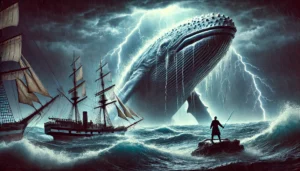Herman Melville’s Moby-Dick is often considered one of the greatest American novels, featuring the legendary white whale that has captivated readers for generations. But with the rise of kaiju culture, characterized by enormous monsters like Godzilla and King Kong, a fascinating question arises: Can Moby Dick be classified as a kaiju? This article explores the characteristics of kaiju and examines whether Moby Dick fits within this thrilling genre.
Understanding Kaiju
Kaiju (怪獣) is a Japanese term that translates to “strange beast” or “monster.” The kaiju genre, popularized by films such as Godzilla (1954) and King Kong (1933), typically features giant creatures that cause widespread destruction and evoke a sense of awe and fear. Key elements of kaiju include:
- Gigantic Size: Kaiju are often enormous, towering over buildings and landscapes.
- Destructive Power: These creatures wreak havoc, often unintentionally, as they navigate human-inhabited areas.
- Symbolism: Kaiju can symbolize various themes, such as nature’s wrath, human hubris, or the consequences of scientific experimentation.
- Cinematic Presence: The visual and auditory impact of kaiju is a significant aspect, often showcased in spectacular battles and city-destroying scenes.
Moby Dick: The Case for Kaiju
- Gigantic Size: While Moby Dick is not as colossal as traditional kaiju, he is described as an unusually large and powerful whale. His immense size and strength are emphasized throughout Melville’s novel, making him an extraordinary creature within the context of his natural environment.
- Destructive Power: Moby Dick exhibits destructive tendencies, not through malice but as a natural response to threats. His encounters with Captain Ahab and other whalers result in significant damage and loss of life, akin to the unintended havoc caused by many kaiju.
- Symbolism: Moby Dick embodies deep symbolic meanings, much like kaiju. He represents the uncontrollable forces of nature, the mysteries of the deep, and the ultimate futility of human endeavors against the natural world. Ahab’s obsession with the whale can be seen as a metaphor for humanity’s relentless and often self-destructive pursuit of dominance over nature.
- Literary Presence: Although Moby Dick lacks the cinematic presence of kaiju, the novel’s vivid descriptions and intense narrative create a powerful image of the whale. Melville’s prose brings the creature to life in the reader’s imagination, achieving an effect similar to the visual spectacle of kaiju films.
Moby Dick: The Case Against Kaiju
- Natural Habitat: Unlike kaiju, which often emerge from the depths to interact with human civilization, Moby Dick remains within his natural oceanic habitat. His conflicts are with individual humans, not entire cities or societies.
- Scale and Scope: Traditional kaiju are gargantuan, often depicted as larger than life and capable of leveling cities. Moby Dick, while large for a whale, does not match the towering scale of creatures like Godzilla or King Kong.
- Cultural Origin: Kaiju are deeply rooted in Japanese culture and cinema, characterized by specific visual and thematic elements. Moby Dick, as a product of American literature, belongs to a different cultural tradition. While he shares some thematic similarities with kaiju, his origin and narrative context are distinct.

Moby Dick straddles the line between a natural creature and a mythical monster. While he lacks the size and scope of traditional kaiju, he shares many symbolic and thematic qualities with them. Ultimately, whether Moby Dick is a kaiju depends on one’s interpretation of the term. If we broaden the definition to include extraordinary natural creatures with significant symbolic weight, Moby Dick could indeed be considered a kaiju. However, if we adhere strictly to the cultural and cinematic characteristics of the genre, he remains a legendary whale, an awe-inspiring force of nature in his own right.
